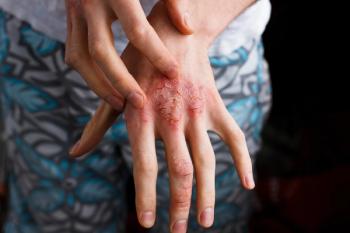
Safety of systemic immunomodulatory drugs in atopic dermatitis
Researchers recently analyzed insurance claims data to investigate the safety and efficacy of off-label immunomodulatory drugs for atopic dermatitis in real life practice. Read what they discovered here.
In cases of severe
Researchers at Brigham and Women’s Hospital in Boston undertook an analysis of insurance claims data to determine and compare rates of occurrence of serious bacterial and opportunistic infections among patients taking the drugs for atopic dermatitis in real life practice.
Five non-biologic systemic drugs – methotrexate, cyclosporine, azathioprine, prednisone, mycophenolate – often used off label in atopic dermatitis were examined; along with dupilumab, the only targeted biologic drug specifically approved for atopic dermatitis; and phototherapy. Phototherapy is generally considered a safe treatment option for patients with recalcitrant atopic dermatitis with most of its safety evidence coming from use in patients with psoriasis.1
Their findings, published in the Journal of the American Academy of Dermatology showed that cyclosporine and methotrexate were associated with the lowest rates of serious infections, and that higher rates occurred with prednisone, azathioprine, and mycophenolate.2 The small amount of available data on dupilumab did not suggest any safety concerns, but the researchers pointed out that since dupilumab has been marketed in the U.S. since March 28, 2017, a more in depth evaluation of it is needed.
The claims data used covered 185 million patients in the U.S. between 2003 and 2017. Patients aged 18 or older with a diagnosis of atopic dermatitis who had not taken an immunomodulating agent in the 6 months prior to initiation of a treatment were included. Patients were excluded if they may have started on a systemic immunomodulatory drug for reasons other than atopic dermatitis, such as rheumatoid arthritis, connective tissue disease, psoriasis, inflammatory bowel disease, cancer or HIV.
Patients were followed up to six months from when they were initiated on their treatment for events of serious bacterial infections, such as cellulitis and abscess, septicemia and bacteremia, pneumonia or opportunistic infections such as pulmonary tuberculosis, listeriosis and leishmaniasis that led to hospital admission.
Data on 232,611 patients were analysed and these showed that the incidence of serious infections was 7.53 per 1,000 (95% confidence interval 7.18-7.89) among patients treated with systemic non-biologics, 7.38 per 1,000 (95% confidence interval 5.68-9.57) among patients treated with phototherapy, and 2.6 per 1,000 (95% confidence interval 0.45-14.3) among dupilumab users.
Regression analysis was used to compare infection rates of the drugs to infection rates with methotrexate. Results showed that cyclosporine had significantly reduced 6-month risk (relative risk =0.87), while prednisone, azathioprine and mycophenolate showed increased risks (relative risks = 1.78, 1.89 and 3.31, respectively).
“Among non-biologic systemic agents, cyclosporine and methotrexate appear to have better safety profiles than mycophenolate, azathioprine and systemic prednisone with regard to serious infections. These findings may help inform clinicians in their selection of medications for patients requiring systemic therapy for atopic dermatitis,” says Joseph Merola, M.D., department of dermatology, Brigham and Women’s Hospital and division of pharmacoepidemiology, department of medicine, Brigham and Women’s Hospital, Harvard Medical School, Boston, Mass.
However, he points out that cyclosporine and systemic prednisone are typically used for induction and flares rather than long-term maintenance, which may have impacted the results, and that duration of use of cyclosporine may be limited by other long-term toxicities considerations, such as nephrotoxicity.
Data on serious infection rates in the small numbers of dupilumab users were compared with those for methotrexate (relative risk =0.33; 0.03 - 3.20), and “encouragingly” showed no increase in risk,” Dr. Merola says. However, he adds that this would need to be confirmed in larger user populations with longer use.
As dupilumab was only marketed in the U.S. from late March 2017, it could only be evaluated on preliminary 2017 data. That data showed one event among 391 patients. “This analysis is limited but does not show an obvious signal for increased risk,” Dr. Merola says.
References:
1. Patrizi A, Raone B, Ravaioli GM. Management of atopic dermatitis: safety and efficacy of phototherapy. Clin Cosmet Investig Dermatol. 2015;8:511-20.
2. Schneeweiss MC, Perez-chada L, Merola JF. Comparative Safety of Systemic Immuno-modulatory Medications in Adults with Atopic Dermatitis. J Am Acad Dermatol. 2019;
Newsletter
Like what you’re reading? Subscribe to Dermatology Times for weekly updates on therapies, innovations, and real-world practice tips.

















